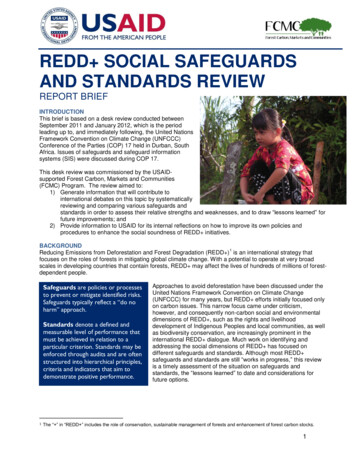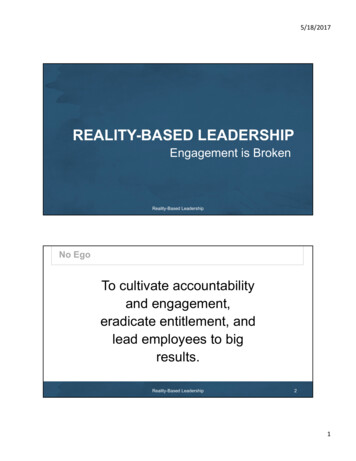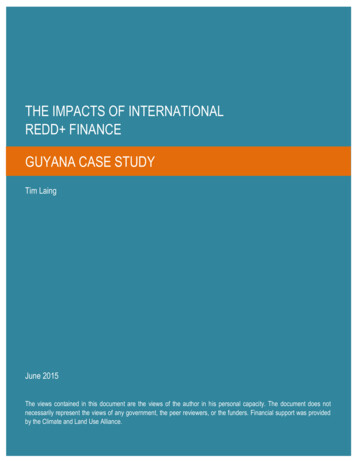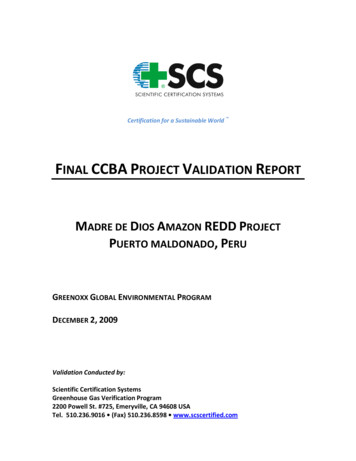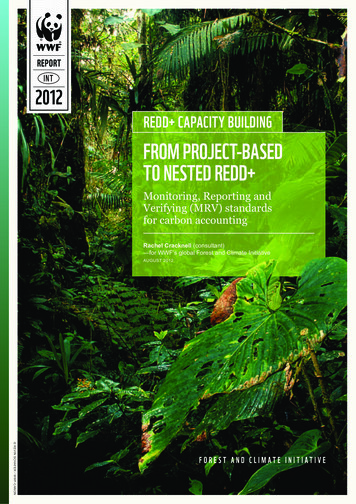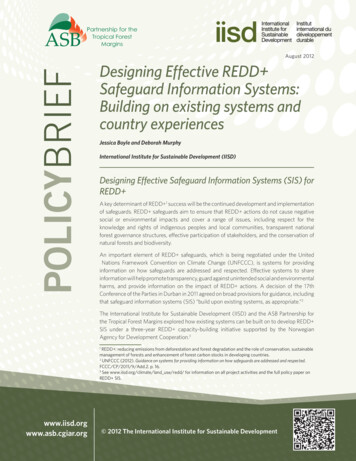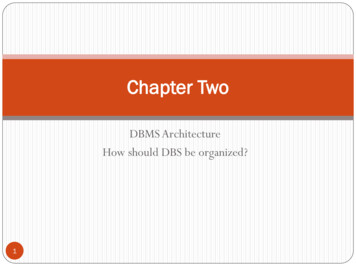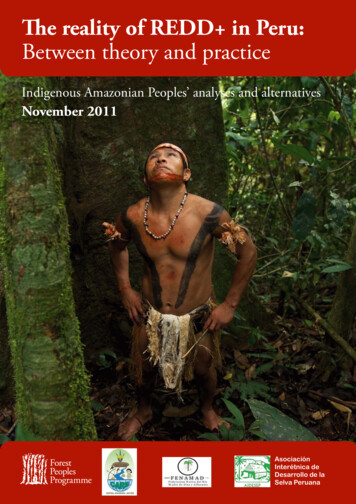
Transcription
The reality of REDD in Peru:Between theory and practiceIndigenous Amazonian Peoples’ analyses and alternativesNovember 2011AsociaciónInterétnica deDesarrollo de laSelva Peruana
The reality of REDD in Peru: Between theory and practiceLead authors: Roberto Espinoza Llanos and Conrad Feather.With thanks to: Paula Acevedo LLanqui, Felipe Pacuri Flores, Julio Pareja Yáñez, Tom Griffiths, Jutta Kill,Gemma Humphrys, Miguel Alexiades, Luis Manuel Claps, Maria-Isabel Griffiths and Aliya Ryan. Any errorsare the responsibility of the authors.Donor acknowledgement: This report has been compiled and published with the support of NORAD. Theviews expressed in this report are those of AIDESEP, FENAMAD, CARE and FPP only.Co-edited by: AIDESEP and FPPNovember 2011Design: Gemma HumphrysMaps: CIPTA, Aliya Ryan, Miguel AlexiadesCover photo: Nahua hunter in his ancestral territory, SE Peru, Johan WildhagenPhoto Part 1: Nahua hunters in their ancestral territory, SE Peru, Johan WildhagenPhotos Part 2 and 6: Nahua children in their community, FPPPhoto Part 3: Border of Manu National Park, SE Peru, FPPPhoto Part 4: Rainbow over the river Pastaza, N Peru, Aliya RyanPhoto Part 5: Nahua men demarcating their ancestral territory, FPPThis reports uses the terms REDD and REDD interchangeably to refer to the overarching but constantlyevolving concept of Reduced Emissions from Deforestation and Degradation.The maps in this report that refer to indigenous territories are broadly indicative based on current data andshould not be interpreted or used to illustrate definitive versions.2
The reality of REDD in Peru: Between theory and practiceContentsREDD Peru : Threat or opportunity?Message from Alberto Pizango Chota, President of AIDESEP4List of acronyms5Executive summary6Introduction and overview8Part OneREDD and Indigenous peoples in Peru: The Context10Part TwoDeveloping a national strategy for REDD : Indigenous perspectives19Part ThreeReality on the ground: Subnational initiatives in Peru affecting Indigenous peoples29Part FourLessons learnt48Part FiveIndigenous alternatives to REDD : A rights based approach55Part SixRecommendations57Annexes613
The reality of REDD in Peru: Between theory and practiceREDD Peru: Threat or opportunity?Alberto Pizango Chota, President of the Interethnic association for the development of thePeruvian Amazon (AIDESEP)We live here in the Peruvian Amazon where there is a new boom, a new fever just like for rubber and oilbut this time for carbon and REDD. The companies, NGOs and brokers are breeding, desperate for thatmagic thing, the signature of the village chief on the piece of paper about carbon credits, something thatthe community doesn’t understand well but in doing so the middle-man hopes to earn huge profits onthe back of our forests and our ways of life but providing few benefits for communities. We denounce this‘carbon piracy’ that is one side of the reality of REDD in the Peruvian Amazon. The other side is the bigprograms of the environmental NGOs, the world bank, the IDB and the government who promise to actwith transparency and respect our collective rights but will this include the respect of our ancestral territoriesand self determination? The safeguards and guidelines of the big projects always say that they will respect ourrights but the reality is always different. What will happen eventually? Which REDD will materialize? Theone of harmony that they offer or one of conflict and broken promises?At the same time the Amazon is being destroyed by climate change itself, an onslaught caused by thetransnational companies and global consumption and resource extraction. This is made worse by localdeforestation caused by loggers, colonists, dams, mines, oil companies and agri-businesses. Can REDDcontrol this industrial destruction or will it only control the activities of communities and small farmers? Theworld does need to reduce deforestation but not in this way, without confusing nature with the accumulationof wealth, without mixing water and oil, without putting life itself onto the stock-market and withoutignoring the real causes of deforestation. For thousands of years indigenous peoples have looked after aliving planet and in only one hundred years industrialisation has caused it to overheat, all in the name of thisconfusing thing they call ‘development’.This report expresses some of these contradiction but it also shows the struggle of AIDESEP to control these‘carbon pirates’ and to analyse the risks and theoretical benefits of REDD. However, we are not only raisingalarms about the reality of REDD, we are also calling for and acting to transform forest and climate initiativesfrom a threat into an opportunity to support our ongoing struggle to protect the forests with indigenousalternatives to REDD driven by our communities that we call “Indigenous REDD”. Will this be possible?We shall see because nothing is written in stone, not even REDD. First will always be our territories, our selfdetermination and our visions for our futures and we will see how to incorporate, or not, policies such asREDD and all the others that come and go as the winds change.We hope that this report will encourage greater understanding, support and solidarity with the work ofindigenous peoples organisations associated with AIDESEP who are working towards ‘la vida plena’ 1 foreveryone.1An indigenous concept similar to ‘good living’ - ‘buen vivir’ or ‘sumac kawsay’4
The reality of REDD in Peru: Between theory and practiceAcronymsACPCAssociation for the Conservation of the Patrimony of CutivireniAFIMADIndigenous Forestry Association of Madres de DiosAMPAAssociation of Amazonians for the AmazonAIDESEPInterethnic Association of the Peruvian AmazonBNDESNational Development Bank of BrazilCAREAsháninka Centre of the River EneCIConservation InternationalCIPTACentre for Information and Territorial Planning - AIDESEPCOPConference of the PartiesCODEPISAMCoordinator of the Development and Defense of the Indigenous Peoples of San MartinCOICACoordinator of Indigenous Organisations of the Amazon BasinCCBACommunity, Conservation and Biodiversity AllianceECOASHÁNINKAThe Executor of the contract for the Administration of the Asháninka Communal ReserveFENAMADFederation of the Native Peoples of the River Madre de Dios and its tributariesFCPFForest Carbon Partnership FacilityFIPForest Investment ProgramFPPForest Peoples ProgrammeFPICFree, prior and informed consentFSCForest Stewardship CouncilGEFGlobal Environment FacilityIADBInter American Development BankIDLLegal Defense InstituteIFCInternational Finance CorporationILOInternational Labour OrganisationIPOIndigenous Peoples’ OrganisationIPIndigenous peoplesMINAMMinistry of the EnvironmentMRVMonitoring, reporting and verificationOCBRCoordinating body for forests and REDD PCParticipants CommitteePESPayments for Environmental ServicesPDDProject Design DocumentR-PPReadiness Preparation ProposalREDD / REDD Reducing Emissions from Deforestation and Forest DegradationSERNANPNational Authority for Protected AreasUNDPUnited Nations Development ProgrammeUNDRIPUnited Nations Declaration on the Rights of Indigenous PeoplesUNFCCCUnited Nations Framework Convention on Climate ChangeWWFWorld Wide Fund for NatureVCSVerified Carbon Standard5
The reality of REDD in Peru: Between theory and practiceExecutive summaryThis report compiled by AIDESEP, FENAMAD, CARE (regional and national indigenous organisations) andFPP collates the experiences of indigenous peoples’ organisations with REDD policies and projects in Peru.The report analyses the policies and strategies of the Peruvian government, examines the roles of internationalagencies and scrutinises pilot REDD initiatives already underway in indigenous territories.The main findings of the report are:At a national level:t Existing REDD policies and programs are undermining rights of indigenous peoples and are likelyto lead to conflicts over land and resources.t Existing national laws on forests, wildlife conservation and land ownership do not uphold Peru’sinternational obligations on indigenous peoples’ rights.t Efforts to protect forests through REDD are undermined by contradictory policies of othergovernment sectors overseeing mining, energy, agriculture, infrastructure and national defence.t Millions of hectares of unresolved indigenous land applications could lead to a mass land grab forREDD projects.t Implementation of REDD is leapfrogging readiness.On the ground:t Lack of national guidelines is resulting in an explosion of carbon piracy and the setting up ofunregulated subnational projects in indigenous territories.t ‘Carbon pirates’ are convincing indigenous communities to sign away their rights to land andcarbon under terms that are highly favourable to commercial interests and offer little or no guaranteefor the protection of indigenous peoples’ fundamental rights.t The impunity of these pirates is providing them with increasing control over forests andthe intellectual property of indigenous peoples and leading to the manipulation of costs and theinequitable distribution of benefits.t Community consultation is occurring only after projects have started.t There is only minimal awareness of REDD and climate policies at a community level.t Information provided by project developers in often partial and/or biased (emphasising benefits andmonetary income, rather than costs and risks).t Understanding of REDD and its complexities is lacking amongst government agencies and projectdevelopers.t Local REDD projects are failing to recognise key principles of FPIC and lack effective FPICprocedures agreed with communities and their freely chosen representative organisations.t Subnational projects fail to recognise international obligations to respect indigenous peoples’ rightsincluding customary land rights.t Voluntary certification standards for REDD projects suffer from serious shortcomings in validationprocesses, including lack of scrutiny, lack of community consultations and failure to reviewcompliance with human rights standards.t Existing subnational projects are often based on technical inconsistencies and arbitrary referencescenarios.‘Indigenous alternatives to REDD ’: From threat to opportunityThe report concludes that unless underlying legal and political reforms are made in Peru to address unresolvedland and territorial applications and uphold the legal obligations of the Peruvian state to respect indigenous6
The reality of REDD in Peru: Between theory and practicepeoples’ rights, then REDD strategies will not only fail to reduce emissions but will undermine these rightsand lead to social conflict. REDD , as it is currently being proposed and developed in Peru, is a threat toindigenous peoples.Despite the negative lessons of existing policies and projects, the report highlights that there is a solution.IPOs have developed their own alternative proposals for protecting forests that prioritise the recognitionand demarcation of indigenous territories as well as support for their own systems for the sustainable useand protection of forest resources. IPOs in Peru also stress that to ensure climate integrity, forest and climateprotection schemes must not be financed by carbon offsetting mechanisms and plantations and biofuels mustbe excluded from REDD schemes. In this way, and in the words of Daysi Zapata Fasabi, Vice President ofAIDESEP:“REDD is a threat to indigenous peoples, our objective is to transform it into anopportunity”RecommendationsInstead of channelling money at unproven and unstable carbon markets, modest funding could be targetedto secure the land and territorial rights of indigenous peoples and promote community forest management.These community and rights based approaches are cost effective and proven approaches to protecting forestthat will not only reduce emissions from deforestation but will lead to poverty reduction, secure livelihoodsand biodiversity conservation. Only in this way can REDD truly become an opportunity for indigenouspeoples instead of a threat. Key recommendations of this report for the Peruvian government and internationalagencies include:t Territory: Recognise and demarcate all outstanding indigenous territorial applications beforeREDD programmes are implemented.t Rights: Align national legislation with international obligations to respect fundamental indigenousrights to land, resources and Free, Prior and Informed Consent (FPIC).t Social justice: Prioritise direct financial support for communities in PES type schemes, promotecommunity based forest management and respect and protect customary resource use and practices,including rotational farming.t Climate and ecological integrity: Exclude REDD and PES schemes from carbon offsettingmechanisms, plantations and biofuel investments.t Deforestation: Target deforestation caused by large scale infrastructure projects, hydroelectric damsand industrial logging rather than discriminating against smallholders and indigenous peoplest Regulation of carbon piracy: Establish a moratorium on the signing of contracts between REDD developers and communities until the fundamental rights of indigenous peoples can be guaranteed.Despite shortcomings in the existing national REDD strategy, significant progress has been made in recentmonths. In a meeting of the World Bank’s Forest Carbon Partnership Facility (FCPF) in March 2011 thePeruvian government committed to reform land tenure legislation to align it with international obligationsand to embark on the process of territorial recognition. The authors of this report and the internationalcommunity will be monitoring their progress with great interest to ensure these commitments are upheld andput into practice.7
The reality of REDD in Peru: Between theory and practiceIntroduction and OverviewREDD development in PeruSince 2008 the Peruvian government has positioned itself as a leading advocate of REDD and its financethrough carbon markets. At the UN climate change conference in Poznan (COP14) the Peruvian Ministry ofthe Environment (MINAM) announced the establishment of its ‘national forest conservation program’ whoseobjective is to protect 54 million hectares of forest and reduce net deforestation to zero by 20201. This strategyhas paid immediate dividends. To date, Peru has been chosen as a pilot country for the World Bank’s ForestCarbon Partnership Facility (FCPF) and Forest Investment Program (FIP) and has received, or had approvalfor, funding for over US 350 million for the preparation and implementation of REDD readiness plans.2Peru’s Readiness Preparation Proposal (R-PP) was finally approved by the FCPF in March 2011.REDD and indigenous peoples’ rightsAt COP 16 in Cancun an international consensus was reached that REDD can only succeed if the rights ofpeople who actually live in the forest are respected. This is particularly relevant to Peru where over a third of its69 million hectares of forest are traditionally occupied and used by Amazonian indigenous peoples and whoseek the full legal recognition of their possession of these lands.3Despite this, the importance given to indigenous peoples’ rights in the development of Peru’s national strategyhas, until very recently, been minimal. Indigenous peoples’ organisations in Peru have reiterated on numerousoccasions that while an estimated 20 million hectares of indigenous territories remain unrecognised and thelegislative framework undermines, rather than strengthens, their rights then REDD is a threat for indigenouspeoples. Until such reforms are undertaken, they argue that current REDD policies will not only fail to benefitthe people who live in the forest or to reduce emissions but are likely to lead to dispossession of indigenouspeoples from their lands and restrictions on their livelihoods.Carbon Piracy: The reality of REDD in PeruConcerns about REDD are no longer hypothetical and nor is carbon only a virtual reality; in the words ofAlberto Pizango, the President of AIDESEP:“”REDD is in the forest and the forest is in indigenous peoples’ territoriesThus, in Peru while the development of national reference levels, monitoring systems, safeguards, risk assessmentsand legal reforms are moving along slowly, sub national REDD initiatives are proliferating. Currently there areat least 35 projects at various stages of design and implementation affecting approximately 7 million hectaresof forest4 almost all of which are being planned and implemented by national or international environmentalorganisations. Of the 35 known projects, at least 11 are planned in officially recognised indigenous lands, whileat least 8 are operating on indigenous peoples’ customary lands that as yet are legally unrecognised (see Map 5).Since colonization the experience of Peru’s indigenous peoples is that outsiders were only really n com content&view article&id catid 1:noticias&Itemid 212Currently there are at least 47 existing funding sources for national REDD activities corresponding to at least 994 million soles although theexact amount of funds available is still unclear. The main contributors include: Japan (252 million), USA (204 million), FIP (180 million), CAF (154million), Germany (117 million) and Perú (30.7 million). See ‘La situación de REDD en el Perú’, DAR, 2011: 43.3This includes 15 million ha of legally recognized territories, as well as approximately 10-20 million hectares whose recognition is pending seeCIPTA, ‘Communal territories and territoriality’. Presentation at Madre de Dios REDD workshop, Puerto Maldonado. 13-14 June 2011.4Ibid: 47.8
The reality of REDD in Peru: Between theory and practicein cutting down their forests. Peru’s indigenous peoples are now experiencing an unprecedented externalinterest in their protection. Today, NGOs, carbon consultants and investors are roaming the jungle in search ofcommunities with carbon offsetting potential. In one case this even involved an effort to convince communitiesto sign away their rights to carbon in a contract with no defined end point. Several of these deals are beingconducted using strict confidentiality clauses and with no independent oversight or legal support for vulnerablecommunities. Some of these peoples are not yet fully literate in Spanish but are being asked to sign complexcommercial contracts in English that are subject to English law. As a result, Peru is rapidly becoming the centreof international carbon piracy. This not only threatens the rights of indigenous peoples but undermines theintegrity of the entire REDD program throughout Peru.Report overviewMuch has been said or written about REDD in Peru5 but existing analyses do little justice to the perspectives ofindigenous peoples or the impact it is having on their lives and lands6. This report attempts to address this gapby providing some of the perspectives of indigenous peoples and their organisations who are experiencing thesedevelopments at first hand and for whom REDD is a source of confusion, expectation and suspicion.This report outlines the current status of REDD at both a national and sub national level in Peru from theperspective of key indigenous organisations whose communities lie in the eye of the REDD storm. It is based onan extended conversation with indigenous organisations and community leaders at a national and regional levelsince 2009, field visits to some of the affected communities, four workshops held with key community leadersin Madre de Dios, San Martin and Ucayali regions of Peru7, analyses of the existing documentation includingPDDs (Project Design Documents8) and contracts of some pilot initiatives and interviews, conversations withkey government, NGO and private sector actors working on REDD at both a national and sub nationallevel. The activities that informed this study were carried out in Peru between May 2010 and June 2011. Thisreport has been co-written and edited by AIDESEP, the national indigenous Amazonian federation of Peru thatrepresents over 1400 indigenous communities in the Peruvian Amazon, and the Forest Peoples Programme(FPP), a UK based NGO that supports forest peoples’ rights. Specific written contributions from regional andlocal indigenous organisations including FENAMAD (Madre de Dios) and CARE (river Ene) are also includedalongside inputs resulting from workshops held with CODEPISAM (Indigenous organisation of San Martin)and ORAU (Regional indigenous organisation of AIDESEP- Ucayali).The report is organised in six sections.t Part 1 outlines the legal, political and territorial context in respect to indigenous peoples in whichREDD is being developed.t Part 2 describes the status of REDD at a national level focusing on the development of Peru’s R-PPand the observations of indigenous organisations.t Part 3 provides an overview of the multiple sub national projects currently underway and an in-depthexamination of a selection of these projects including some detailed case studies.t Part 4 reviews the lessons learnt from these experiences at a national and subnational level.t Part 5 summarises the alternatives to REDD that indigenous peoples are proposing.t Part 6 proposes recommendations to address the shortcomings in current REDD developments atthe level of policy and practice.5See ‘La situación de REDD en el Perú’, DAR, 2011 for an overarching review.6A notable exception which addresses some of these issues is: ‘Inclusión social en el proceso REDD en el Perú’, Die, GIZ, 2011.7ORAU (7-10 May 2010 and 27-29 June 2011), FENAMAD (13/14 June 2011), CODEPISAM (19-20 May 2011).8Project Design Document is the general term given to the written submissions of REDD project developers that outline the nature and scope ofthe REDD project and are required by the certification agencies to complete their evaluation.9
The reality of REDD in Peru: Between theory and practicePart 1Forests and indigenous peoples in Peru: The contextIn order to understand the key issues relating to REDD it is first necessary to appreciate the political, legaland territorial context in which these initiatives are being developed. This first section provides an overview ofthe key issues.Forests and Indigenous peoples in PeruThe Peruvian Amazon houses almost 70 million ha9 of tropical rainforest approximately 15 million hectaresof which is either legally recognised with some form of indigenous ownership or management10. Census datafrom 2007 indicates that the indigenous population of the Amazon is over 330,000 and pertains to at least60 different peoples and 17 different language families11. The state acknowledges that there are at least 8million hectares of pending applications for proposed indigenous reserves but recent and on-going researchdemonstrates that there are at least 102 communities that are neither recognised as existing nor with legaltitle to their lands, 525 communities that are recognised but have not been titled and 178 communities withpending applications for extensions as their titles are too small to physically support their populations12. Apartfrom these there is strong anecdotal evidence of hundreds of ‘invisible’ communities whose existence is noteven informally recognised.In addition to these pending community title applications there are at least ten well advanced initiatives13 tosecure the recognition of their collective territories as peoples which amount to an extension of over five millionha (see Map 1). See Box 2 for a summary of the results so far of this gap analysis and Annex A for a detailedreview by region.9‘Readiness Preparation Proposal’, p47. MINAM, January 2011.10See Box 1 for more details and CIPTA, ‘Communal territories and territoriality’. Presentation at Madre de Dios REDD workshop, PuertoMaldonado. 13-14 June 2011.11IBC, 2011, ‘Mapa Amazonia Peruana’ 2011. These are the official statistics but the actual numbers are likely to be much higher owing tolimitations of the census.12CIPTA, ‘Communal territories and territoriality’. Presentation at Madre de Dios REDD workshop, Puerto Maldonado. 13-14 June 2011.13To date this includes the 8 peoples mentioned in Map 1 as well as the Ese Eja in Madre de Dios.10
The reality of REDD in Peru: Between theory and practiceBox 1: Principal categories of indigenous land ownership in the Peruvian AmazonCategoryProperty and use rights according to Peruvian legislationNativeOwnership rights over fishing and agricultural resources. Forest rights are ceded incommunityexclusive use and commercial use of forest resources requires permits from the forestryauthority but ownership rights retained by the state. Since constitutional modificationsin1993, titles are no longer inalienable or unseizable.ITerritorialReserves forisolated peoplesCommunalReservesUndemarcated land titles that safeguard the land until the inhabitants establish a formalnative community. No commercial activities are permitted although this has beenrepeatedly violated by oil and gas exploitation within the borders of the Reserves.Indigenous territories recognized as natural protected areas that are co-managed by theprotected areas authority (SERNANP) alongside an indigenous organisation awardeda contract for managing the Reserve whose representatives are elected by surroundingcommunities. Communal reserves permit subsistence and some commercial activities onthe part of neighbouring communities on the basis of a Master plan developed for eachReserve approved by SERNANP. No commercial use of forest resources is permitted butthe State retains rights to exploit subsurface resources.I Article 89 of the constitution states that, “property of these lands is imprescritible except in the case of abandonment”. The 1979 constitution of Peru(Art 163) recognised the unseizable, inalienable and imprescriptible legal character of indigenous territories.Box 2: Outstanding indigenous territory and land applications in the Peruvian AmazonForestry concessions and indigenouslandsOil, gas and mining concessions50 overlaps with indigenous areasI.ReservesTerritorial reservesRecognised5 Reserves exist: Total area:2’856,223.32 HaCommunal reserves6 Reserves exist. Total area:1’663,966.25 HaTitled and demarcated Nativecommunities‘Invisible’ communitiesUnrecognised communities1254 communities10,707,812 HaHundreds that have yet to be documented102 identified to dateRecognised Communities requiringtitling525 identified to dateCommunity titles requiringextensionsTerritorial application to date178 identified to dateIOil and gas: 47,961,405ha (covering 61.2% of the PeruvianAmazon. These overlap 4 territorial reserves, 5 communal reservesand at least 70% of native communitiesMining: 2,510 087haIIPending5 pending:Cacataibo, Tapiche- BlancoYaquerana, Yavari-Mirim,Napo-Tigre, Kapanawa (Sierradel Divisor). Total area:4’242,484.87 has8 Pending: Airo Pai, Huimeki,Napo Curaray, Chambira,Tigre Corrientes, Tamaya Caco,Inuya-Tahuanía, Yurúa. Totalarea4’108,565.75 hasIncluding: Ese Eja, Achuar, Chayahuita, Shiwilo, Candoshi ,Cocama-Cocamilla, Quichua, Awajun, Huampis, ShapraIBC cited in ‘Large acquisition of rights on forest lands for tropical timber concessions and commercial wood plantations’ ILC and RRI, 2011, p30.II IBC, 2011, ‘Mapa Amazonia Peruana’ 2011, see Map 3.11
The reality of REDD in Peru: Between theory and practiceMap 1: Indigenous peoples seeking recognition of collective territories by indigenous peoples inNorthern Peru, CORPI, 20111414Several of these proposals have now been formally presented to the appropriate authorities such as that of the Achuar of Datem province,March 2011, http://servindi.org/actualidad/41124.12
The reality of REDD in Peru: Between theory and practiceIndigenous peoples’ rights to land and forests in Peru15 million hectares may seem significant but a comparative review of the rights of indigenous Amazonianpeoples illustrates that the legal status of indigenous peoples’ land and resource rights in Peru is amongst themost precarious in the Amazon basin15. Unlike their neighbours in Colombia, Brazil, Bolivia and Ecuador, thecharacter of indigenous peoples’ land rights in Peru are no longer inalienable or unseizable but have steadily beendowngraded in status by constitutional and legal reforms in the last 20 years. Even within titled areas indigenouspeoples have use rights but not ownership over forests which is claimed by the State.Indigenous peoples’ relationship with forests in PeruFor indigenous Amazonian peoples the forest is synonymous with life itself. Despite some integration into themarket economy many retain an intimate relationship with the forests that they continue to depend on not onlyfor their livelihood but for their sense of unique identities as peoples. Forests provide physical sustenance inthe form of hunting and fishing grounds, wild fruits and seeds, fire wood and agricultural land for cultivation.It is a vital source of materials for construction and tools, fibres for weaving clothing as well as medicines andsubstances that enable the critical relationship with non humans that underly their cosmologies. The nature ofthis relationship can be seen in the map below that illustrates Ese Eja resource use in a section of their ancestralterritory and demonstrates the interdependence of their relationship with the forest.Integration into the market economy, poverty and extractive industriesDespite the critical importance of theforest for their way of life and cultures, theconnection between indigenous peoplesand their forests has been progressivelyundermined over many years as a resultof a variety of factors. Governmentpolicies have opened up their forests forextraction of natural resources, illegal anduncontrolled logging, gold mining andother extractive industries hav
rights but the reality is always different. What will happen eventually? Which REDD will materialize? The one of harmony that they offer or one of conflict and broken promises? At the same time the Amazon is being destroyed by climate change itself, an onslaught caused by the transnational companies and global consumption and resource extraction.

